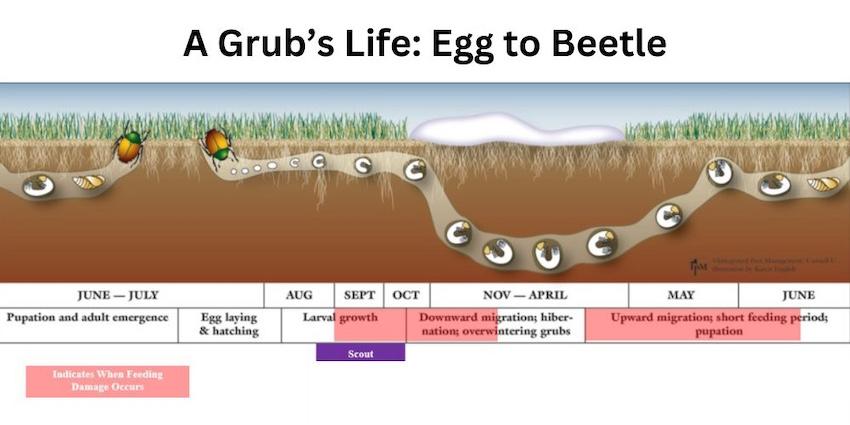Notably, in a healthy turf system that incorporates All-Natural Products to encourage a diverse biological soil profile, grubs tend not to be a problem. In addition, research has shown that a higher height of cut (3.5″ and above) helps develop a root mass large enough to withstand drub damage. In our 20+years in the organic industry we have found this to be true and very rarely do we need to treat. In instances when intervention is needed, you have options to treat grubs without harmful chemicals.

Treat Grubs Without Harmful Chemicals
The emergence of grubs in the Northeast can be delayed by cool, dry weather and is also affected by the grub species. Generally, the best time to scout is mid-August to mid-September. If more than 7 -8 grubs are found per square foot, it is a good idea to treat. There are several products on the market today for consideration.
Cedarwood Oil
Due to extended drought conditions over the last several years, we’ve treated grubs using cedar oil with a backpack sprayer and have had great success. Mode of Action: Grubs’ exposure to the cedarwood oil triggers the erosion of the exoskeleton. Insects exposed will stifle the ability of the insects’ receptors to detect food, mates, and to reproduce. When these comfort levels are destroyed, insects become overwhelmed and relocate.1 We have been using CedarCure which is a minimum risk pesticide compliant with EPA 25b. Therefore making it exempt from registration by the US Environmental Protection Agency.
One downside of using cedar oil is that it is a non-selective and may adversely effect other beneficial soil biology. For that reason, we only treat the border areas where grubs have been found and do not blanket spray. The application of our all-natural fertilizer after a cedar oil spray can help the beneficial soil biology to propagate after an application.
hB nematodes
When soil moisture has been good we have also had success using beneficial hB nematodes. hB nematodes are microscopic parasitic worms that are a natural predator of a variety of pest insects. Beneficial nematodes enter the grubs and consume them from the inside out. They are semi-aquatic and require moist soil conditions to move around and attack and feed on white grubs. One down side of hB nematodes is because they are semi aquatic, drought conditions and watering restrictions can impact their effectiveness. It’s important to purchase nematodes from a reputable source because they are alive and microscopic – so you can’t see them. We recommend purchasing directly from the manufacturer to be sure they are healthy and living.
grubGONE!
There is another bio-insecticide on the market called grubGONE. GrubGONE can be applied as a preventive measure or as a curative option. GrubGONE is a biological, granular, insecticide that can be applied through a spreader. While we don’t have firsthand experience using this product, it claims to be effective against 1st-3rd instar grubs. The active ingredient is Bacillus thuringiensis subspecies galleriae (Btg). To reproduce, Bt makes spores that grow into new bacteria. Bt spores have proteins that are toxic to insect larvae when eaten. The Bt protein once ingested will kill the grub. Note, grubGONE is a registered with the EPA.
Caution: Bt protein is also toxic to nematodes, so combining the use of hB nematodes with grubGONE! would not be recommended.
Need help managing grubs without the use of synthetic pesticides? Contact PJC!
Be sure to check with your state pesticide board to see if you need a license to apply 25b exempt products—this varies state to state.
